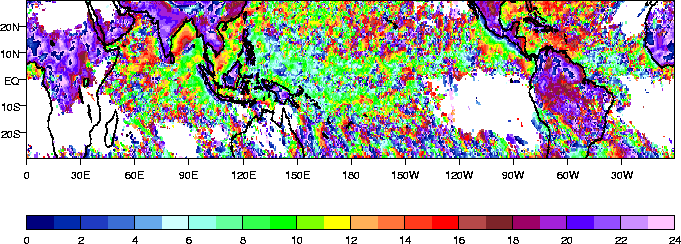
Coordinator: Julia Slingo
1. The development of a high resolution climatology of the diurnal cycle in convection, cloudiness and surface temperature has revealed several interesting facets, including the extent to which the strong diurnal signal over land is spread out over the adjacent oceans, probably through gravity waves of varying depths.
An archive of high resolution (3 hourly, 0.5 latitude/longitude grid) global window brightness temperature data from multiple satellites has been used to construct a climatology of the diurnal cycle in convection, cloudiness and surface temperature for all regions of the tropics. The results have demonstrated the universality of the characteristics of the diurnal cycle for land vs. ocean, clear sky vs. convective regimes. The maximum diurnal amplitude occurs over land clear sky regions, as a result of the large response of the surface temperature to daytime solar heating. For convective regimes, the diurnal amplitude is larger over continents than over oceans, and the phase of the diurnal harmonic is more spatially consistent. Oceanic deep convection tends to reach its maximum in the early morning. Continental convection generally peaks in the evening, although there are interesting regional variations, indicative of the effects of complex land-sea and mountain-valley breezes, as well as the life cycle of mesoscale convective systems (Figure 1(a)).

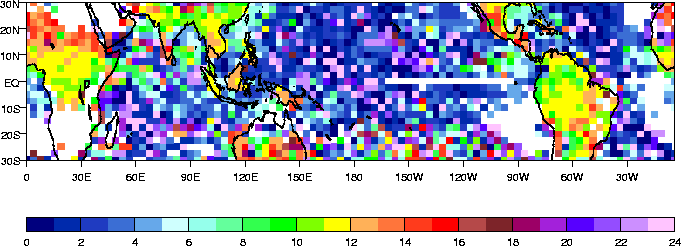
A striking result has been the extent to which the strong diurnal signal over land is spread out over the adjacent oceans, probably through gravity waves of varying depths. These coherent signals can be seen for several hundred kilometres and in some instances, such as over the Bay of Bengal, can lead to substantial diurnal variations in convection and precipitation. Over the complex system of islands which make up the Maritime Continent, these coherent signals in the diurnal cycle represent important land-sea breeze effects which may play a crucial role in the region's heat and moisture budget.
A complementary analysis of the diurnal cycle in the Met. Office Unified Model has demonstrated that the model has considerable difficulty in capturing the observed phase of the diurnal cycle in convection (Figure 1(b)), which suggests some fundamental difficulties in the model's physical parametrizations. Analysis of the diurnal cycle represents a powerful tool for identifying and correcting model deficiencies.
2. Time series analysis has been used to demonstrate that, firstly, tropical convection is frequently organised by equatorial waves whose dynamical structures are consistent with theory, and secondly, that the activity of these waves is substantially modified by the phase of ENSO and by the interaction with mid-latitude Rossby waves.
ECMWF Reanalyses and high resolution satellite data have been used to identify convectively coupled equatorial waves. The application of space-time spectra and temporal filtering has demonstrated that tropical convection is frequently organised by equatorial waves whose dynamical structures are consistent with theory. In addition, it has also been demonstrated that the dispersion characteristics of some aspects of tropical variability are consistent with the influence of extratropical Rossby waves, which penetrate the deep tropics in regions of mean westerly flow, the so-called westerly ducts over the equatorial East Pacific and Atlantic Oceans.
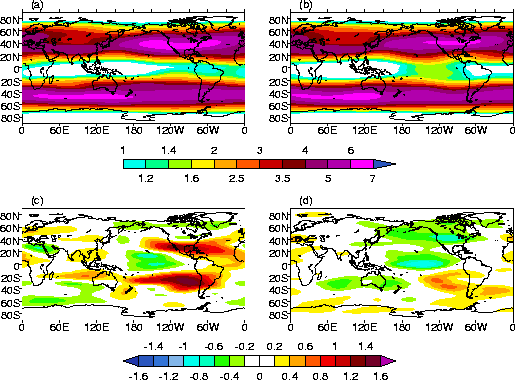
The impact of the phase of ENSO on the penetration of extratropical Rossby waves is demonstrated in Figures 2(a)-(c) which show the geographical distribution of the standard deviation of eastward moving Rossby waves in El Nino and La Nina winters. As expected, the strongest Rossby wave activity occurs in the extratropics, associated with jet wave guides and storm tracks. Dramatically different behaviour in the activity of Rossby waves penetrating into the equatorial regions is evident, associated with changes in the upper tropospheric zonal flow. In El Nino (La Nina) winters more Rossby waves penetrate into the equatorial Atlantic (eastern Pacific) westerly duct. The activity of the westward moving Rossby waves, which is largely confined to the tropics, is also modulated by ENSO (Figure 2(d)). There is a reduction in the activity of the equatorial Rossby waves which may be associated with the reduced penetration of extratropical waves into the deep tropics. This is consistent with earlier studies which have suggested that upper level troughs in the westerly ducts can excite equatorial westward moving waves. In the extratropics, westward moving Rossby waves are probably the signature of blocking events which tend to retrogress; the results therefore suggest a reduction in blocking over North America in El Nino winters.
3. It has been shown that the influence of intraseasonal SST anomalies on the organisation of tropical convection favours longer timescales (~60 days), typical of the MJO. A characteristic timescale of ~ 5 days has been identified for the adjustment of the atmospheric humidity profile to changes in SST necessary for the initiation of deep convection.
A coherent relationship has been identified between the observed surface fluxes, convection and SST on intraseasonal timescales throughout the tropical Indian and Pacific Oceans. This has been used to form the basis of a series of experiments with the aquaplanet version of the UM to investigate the organisation of tropical convection by these intraseasonal SST anomalies and how this organisation depends on the temporal behaviour of these SST anomalies. A series of experiments have been performed with an eastwards moving tropical SST dipole anomaly, typical of the observed SST anomalies, which propagates with speeds of 0, 4, 6, 8, 12 day-1 on a zonally symmetric SST profile.
The results have shown that for the stationary case the maximum in precipitation lies over the maximum in SST, whereas for the moving anomaly cases, the maximum precipitation is shifted to the west. Also the faster the propagation speed of the anomaly the smaller the response by the precipitation. Detailed analysis of the results has shown that there is an adjustment timescale of ~ 5 days for the convection to respond to the SST which involves the build up of moisture in the troposphere. The boundary layer adjusts very quickly to the SST anomaly and the enhanced low-level instability leads to convection over the region of the warm SST, although the relatively dry air above the boundary layer inhibits the development of deep convection. As the SST anomaly goes past, the convection takes place in a progressively moister environment and more of the moisture carried in the convective plume is converted to precipitation. This process explains why the precipitation in the moving SST anomaly experiments is shifted to the west of the SST anomaly. It also explains why the faster SST anomaly has a smaller precipitation anomaly associated with it. In the case with the faster moving SST anomaly the convection has less time to moisten the middle troposphere before the low-level instability is removed.
This mechanism explains how intraseasonal SST anomalies can potentially organise convection, which favours the longer timescales (~60 days), typical of the observed MJO, and which produces a phase relationship between the convection and SST, consistent with the observed structure over the Indian and West Pacific Oceans.
4. The simulation of the MJO in the Unified Model has been shown to be sensitive to vertical resolution in the free troposphere. The importance of cumulus congestus clouds, which detrain near the freezing level, in preconditioning the tropical atmosphere for organized convection has been suggested.
The simulation of the MJO in AMIP II integrations of the UM with observed SSTs for 1979-95 has been analysed. In particular, the sensitivity to vertical resolution has been assessed by comparing the results from the standard configuration of the model with 19 levels in the vertical (L19), with a version with 30 vertical levels (L30). In the L30 version, the extra levels are in the middle and upper troposphere, decreasing the layer thickness in mid-troposphere from 100 hPa to 50 hPa. The L19 version has a rather weak and incoherent MJO signal whereas the L30 version has variability of the correct amplitude and a signal that propagates coherently eastwards, albeit rather too quickly in common with many other GCMs (Figure 3(a)).
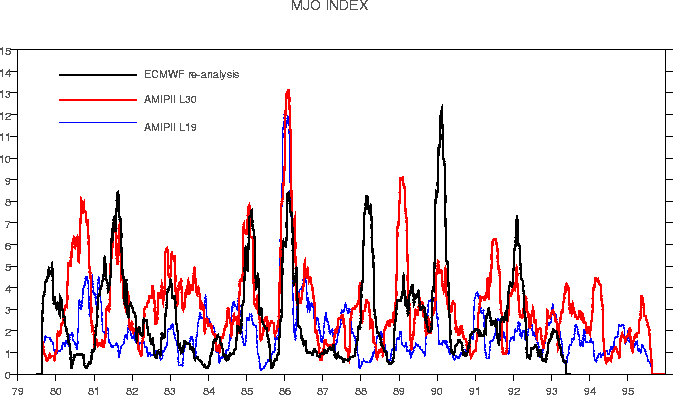
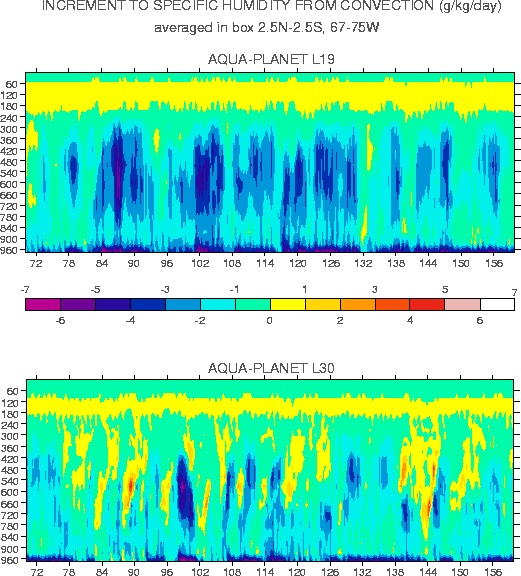
In order to understand these differences, integrations of the L19 and L30 versions of the UM in aqua-planet mode have been used to study the temporal behaviour of tropical convection. The results have shown that the L19 version is dominated by deep convection which dries the troposphere due to parametrized subsidence between clouds. The L30 version shows periods of several days when the convection penetrates only to mid-troposphere, providing a source of moisture through detrainment at cloud top (Figure 3(b)). This shallower convection is prevented from becoming deeper by a stable layer that develops around the OoC level in response to the melting of precipitation during periods of deep convection. This stable layer is more sharply resolved at L30 since the model layers at this level are only 50 hPa thick as opposed to 100 hPa in L19.
Observational studies such as TOGA-COARE in the west Pacific have shown that, during the suppressed phase of the MJO, tropical convection is dominated by clouds which terminate around the stable layer at the 0oC level. These clouds do indeed provide a source of moisture to the mid-troposphere and thus pre-condition the atmosphere for the next period of enhanced convection. This suggests that there is a natural `recharge-discharge' time-scale for convection over warm SSTs which may be partly responsible for setting the period of the MJO.
Contributors: Brian Hoskins, Pete Inness, Julia Slingo, Steve Woolnough, Gui-Ying Yang